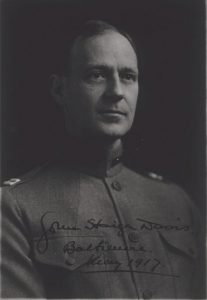
Plastic surgery has become something we take for granted in modern medicine as an important tool for healing those injured in warfare, but that wasn’t always the case. In the early 20th century, Dr. John Staige Davis worked tirelessly to raise the profile of plastic surgery as a medical specialty. During the First World War, Davis served as a captain in the US Army Medical Corps and was part of a committee tasked with organizing plastic surgery units for the Army Medical Corps. With veterans returning home wounded and disfigured, Davis saw plastic surgery as a necessity in helping to restore normalcy to their lives. Though his practices were primitive when compared to the complex procedures that are routine today, Davis was a pioneer in his field and the first doctor in the United States to have a practice dedicated wholly to plastic surgery. Davis published the field’s first textbook, titled Plastic Surgery: Its Principles and Practices, in 1919.
A graduate of Yale University (1895) and Johns Hopkins School of Medicine (1899), Davis felt that if his book was useful “in bringing relief to any one of our wounded soldiers who require the aid of a plastic surgeon” then the effort he had put into it would be worth it. Davis’ legacy can be seen in plastic surgery programs for veterans like the American Society of Plastic Surgeons’ Project C.A.R.E, a project dedicated to providing military personnel with free, high quality plastic surgery services as they adjust to civilian life. Today at Johns Hopkins, several divisions (including the School of Medicine, School of Engineering, and Applied Physics Laboratory) continue to pursue cutting edge research that will improve the care of veterans.
The Hopkins and the Great War exhibit (on display from September 2016 to January 2017) explores the impact of World War I on the Hopkins community. The section of the exhibit installed in MSE Library addresses the war’s effect on the Homewood campus. To learn more about World War I, plastic surgery and John Staige Davis’ efforts, visit the Hopkins and the Great War exhibit on display in the Welch Medical Library Building, or visit the comprehensive digital exhibit.
